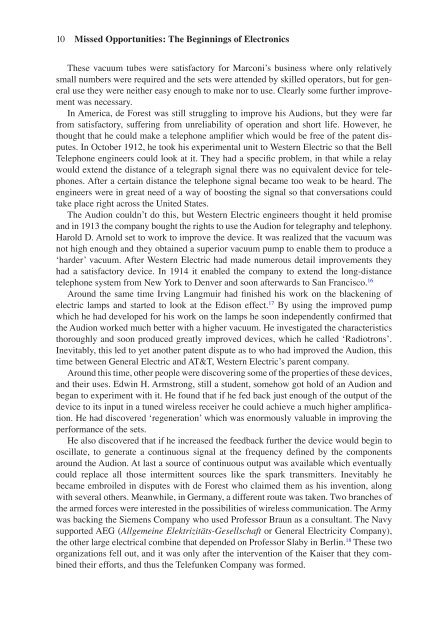The Electronics Revolution Inventing the Future
You also want an ePaper? Increase the reach of your titles
YUMPU automatically turns print PDFs into web optimized ePapers that Google loves.
10 Missed Opportunities: <strong>The</strong> Beginnings of <strong>Electronics</strong><br />
<strong>The</strong>se vacuum tubes were satisfactory for Marconi’s business where only relatively<br />
small numbers were required and <strong>the</strong> sets were attended by skilled operators, but for general<br />
use <strong>the</strong>y were nei<strong>the</strong>r easy enough to make nor to use. Clearly some fur<strong>the</strong>r improvement<br />
was necessary.<br />
In America, de Forest was still struggling to improve his Audions, but <strong>the</strong>y were far<br />
from satisfactory, suffering from unreliability of operation and short life. However, he<br />
thought that he could make a telephone amplifier which would be free of <strong>the</strong> patent disputes.<br />
In October 1912, he took his experimental unit to Western Electric so that <strong>the</strong> Bell<br />
Telephone engineers could look at it. <strong>The</strong>y had a specific problem, in that while a relay<br />
would extend <strong>the</strong> distance of a telegraph signal <strong>the</strong>re was no equivalent device for telephones.<br />
After a certain distance <strong>the</strong> telephone signal became too weak to be heard. <strong>The</strong><br />
engineers were in great need of a way of boosting <strong>the</strong> signal so that conversations could<br />
take place right across <strong>the</strong> United States.<br />
<strong>The</strong> Audion couldn’t do this, but Western Electric engineers thought it held promise<br />
and in 1913 <strong>the</strong> company bought <strong>the</strong> rights to use <strong>the</strong> Audion for telegraphy and telephony.<br />
Harold D. Arnold set to work to improve <strong>the</strong> device. It was realized that <strong>the</strong> vacuum was<br />
not high enough and <strong>the</strong>y obtained a superior vacuum pump to enable <strong>the</strong>m to produce a<br />
‘harder’ vacuum. After Western Electric had made numerous detail improvements <strong>the</strong>y<br />
had a satisfactory device. In 1914 it enabled <strong>the</strong> company to extend <strong>the</strong> long-distance<br />
telephone system from New York to Denver and soon afterwards to San Francisco. 16<br />
Around <strong>the</strong> same time Irving Langmuir had finished his work on <strong>the</strong> blackening of<br />
electric lamps and started to look at <strong>the</strong> Edison effect. 17 By using <strong>the</strong> improved pump<br />
which he had developed for his work on <strong>the</strong> lamps he soon independently confirmed that<br />
<strong>the</strong> Audion worked much better with a higher vacuum. He investigated <strong>the</strong> characteristics<br />
thoroughly and soon produced greatly improved devices, which he called ‘Radiotrons’.<br />
Inevitably, this led to yet ano<strong>the</strong>r patent dispute as to who had improved <strong>the</strong> Audion, this<br />
time between General Electric and AT&T, Western Electric’s parent company.<br />
Around this time, o<strong>the</strong>r people were discovering some of <strong>the</strong> properties of <strong>the</strong>se devices,<br />
and <strong>the</strong>ir uses. Edwin H. Armstrong, still a student, somehow got hold of an Audion and<br />
began to experiment with it. He found that if he fed back just enough of <strong>the</strong> output of <strong>the</strong><br />
device to its input in a tuned wireless receiver he could achieve a much higher amplification.<br />
He had discovered ‘regeneration’ which was enormously valuable in improving <strong>the</strong><br />
performance of <strong>the</strong> sets.<br />
He also discovered that if he increased <strong>the</strong> feedback fur<strong>the</strong>r <strong>the</strong> device would begin to<br />
oscillate, to generate a continuous signal at <strong>the</strong> frequency defined by <strong>the</strong> components<br />
around <strong>the</strong> Audion. At last a source of continuous output was available which eventually<br />
could replace all those intermittent sources like <strong>the</strong> spark transmitters. Inevitably he<br />
became embroiled in disputes with de Forest who claimed <strong>the</strong>m as his invention, along<br />
with several o<strong>the</strong>rs. Meanwhile, in Germany, a different route was taken. Two branches of<br />
<strong>the</strong> armed forces were interested in <strong>the</strong> possibilities of wireless communication. <strong>The</strong> Army<br />
was backing <strong>the</strong> Siemens Company who used Professor Braun as a consultant. <strong>The</strong> Navy<br />
supported AEG (Allgemeine Elektrizitäts-Gesellschaft or General Electricity Company),<br />
<strong>the</strong> o<strong>the</strong>r large electrical combine that depended on Professor Slaby in Berlin. 18 <strong>The</strong>se two<br />
organizations fell out, and it was only after <strong>the</strong> intervention of <strong>the</strong> Kaiser that <strong>the</strong>y combined<br />
<strong>the</strong>ir efforts, and thus <strong>the</strong> Telefunken Company was formed.


















